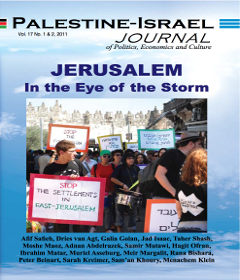The philosopher John Austin has pointed out that we always do things with words. The terms we use to describe the West Bank barrier reveal our politics.1 For its Israeli proponents, it is the "security" or "anti-terrorist" fence. For its Israeli opponents and for Palestinians, it is the "apartheid," "segregation," "separation," "colonization," "demographic" or "annexation" wall. The barrier consists partly of a concrete wall in populated areas and an elaborate fence system in rural areas. The Israeli Ministry of Foreign Affairs maintains that the "security fence" is nothing like the Berlin Wall. Indeed, there are differences. The maximum height of the Berlin Wall was 3.65 meters; the West Bank wall is up to 8 meters high. Where the barrier turns into concrete slabs it becomes a canvas. Palestinian, Israeli and international graffiti artists make the gray concrete speak in multiple tongues. This has sparked "conflict tourism." Tourists get bused into Abu-Dis, a neighborhood cut off from Jerusalem by the barrier, to stand in the shadow of the wall and read its voices.
On the Palestinian Side of the Wall…For Palestinians, the wall becomes a message board to share information, affirm Palestinian national identity and post calls for resistance and unity.2 Palestinian artists tend to use a darkened palette, often using the colors of their national flag (Fig.1).3 On the walls of Abu-Dis, black, white, green and red Arabic letters state: "The right to return (of Palestinian refugees) is a right that doesn't die." Nearby, drawings of giant house keys reaffirm the rights of the dispossessed to return to their homes.
Palestinian Symbols Such as the Dome of the Rock, the Sabra and HandalaMany Palestinian artists also draw on well-known Palestinian symbols, such as the Dome of the Rock, which is presented as being beyond reach - on the other side of the wall.4 In places, green shoots of olive trees and the prickly thorns of the sabra cactus seemingly grow out of the mass of gray concrete.
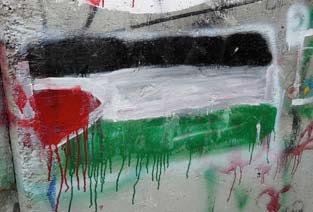
Fig.1
Rather than using the wall as a symbol to speak about human dignity and cultural bridges, many Palestinian graffiti artists tend to draw attention to the daily struggles of Palestinians living in its shadow. For them the ugliness and enormity of the wall speaks for itself. Simply depicting Palestinians tending their land and drinking tea in the face of the wall speaks to the reality of oppression and their sense of imprisonment.6
International Images of Solidarity and Human RightsInternational graffiti artists, on the other hand, use the wall to show solidarity, to raise awareness about human suffering and to bridge cultures. The mission for the "Break the Silence" mural project (http://www.breakthesilencearts.typepad.com/) is to raise international awareness about Palestinian issues and inspire action. "Artists against the Wall" (http://www.imemc.org/article/17832) also created art installations to speak to the common humanity of people on both sides of the wall. For artists from the project Face2Face (http://face2faceproject.com/), oversize images of Palestinians and Israelis pasted onto the Bethlehem walls are meant to show their similarity. Despite their best intentions, the images have been shredded and defaced.
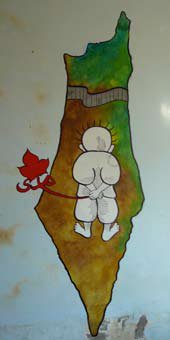
Fig.2
For others, the wall becomes a symbol to speak about universal human rights. On a watchtower dominating the Aida refugee camp, a New York street artist depicted a woman with a flowing skirt full of pockets (Fig.3) that contain papers with inspiring quotes by civil rights leaders such as Martin Luther King, Jr. about human rights, dignity and freedom. Escalators, balloons and ladders also speak of artists' dreams of overcoming the wall (Fig.4).
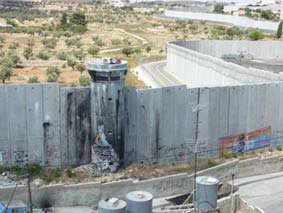
Fig.3
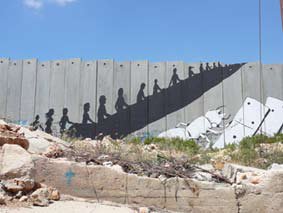
Fig.4
Images by international artists at times clash with the locals' perceptions. The living room window that opens onto a peaceful green scenery (drawn by well-known British artist Banksy) has become "de-beautified" and gives way to a brick wall. Indeed, when Banksy painted large murals onto the Bethlehem walls, a Palestinian onlooker told him that he made the wall look beautiful. Banksy thanked him only to be told, "We don't want it to be beautiful. We hate this wall. Go home."7 However, for Palestinian taxi drivers, Banksy's nine stencil murals are good business. They can offer a "special price" to international tourists who come to Bethlehem not only for a pilgrimage to the Church of the Nativity, but also to get a tour of Banksy's images they have read about in the Guardian and the New York Times. Indeed, the wall's commercial potential has not been lost on people living in its shadow. People with Internet access could, until recently, go to http://www.sendamessage.nl where they were told, "Put your message on the wall, order now!" This gave a whole new meaning to love letters sent to your beloved.
And on the Israeli Side of the Wall…On the Israeli side, along Route 443 from Jerusalem to Tel Aviv, the Jerusalem municipality has decorated the walls that shield against the Palestinians with green meadows and blue skies framed by murals of viaducts. Larry Abramson, an Israeli artist critical of the barrier, appropriated the green and blue landscape but added a vertical black zip across it to question the Zionist dream of virgin open land.8 However, on the ground, the walls lining Route 443 look like sound barriers (against highway noise) that make the Palestinian topography beyond disappear. Around the Palestinian cities of Tulkarm and Qalqilya, the walls themselves have also largely become invisible to Israelis driving along the adjacent Highway 6. Heaps of soil, planted trees, bushes and plants cover the mass of concrete behind.
The walls around the Jewish enclave of Gilo were erected in 2002 against sniper attacks from Beit Jala. Until the Israel Defense Forces (IDF) started to dismantle it in August 2010, it presented a wall gallery. Gilo residents created its images at the request of the Jerusalem municipality. Some of the concrete slabs were painted over with replications of the shielded-off landscape beyond (Fig.5).
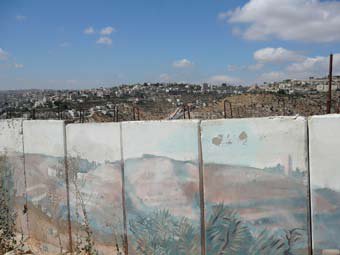
Fig.5
Others evoked an imaginary biblical and peaceful landscape (Fig.6).
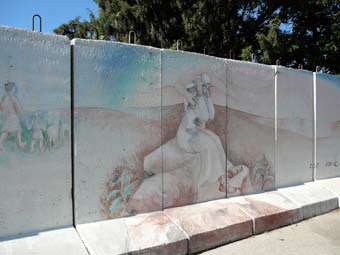
Fig.6
Lovers on swings gazed dreamingly into the sunset (Fig.7) and cyclists freely navigated in open spaces.
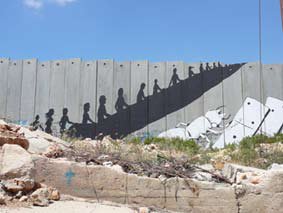
Fig.7
Maps of Jewish sites from the city of Tel Aviv to the Knesset evoked a Jewish topography and land in which the threatening "Other" beyond has become invisible and has disappeared altogether (Fig.8).9
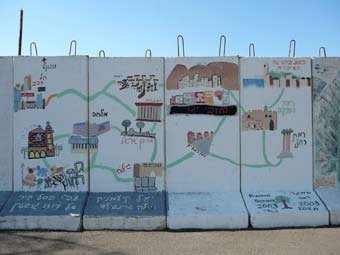
Fig.8
Israeli artists also use the wall as a symbol to raise awareness about the plight of Palestinians. As many Israelis have never seen the barrier, some artists take it to be their mission to show how it affects people, lands and cultures on either side. Others also use the wall to speak to issues unrelated to the consequences of the barrier. Indeed, the Tel Aviv fashion house Comme Il Faut did a series of fashion shoots of their 2004 collection by the wall (http://www.comme-il-faut.com/agenda/archive/Catalogs/Frontiers). The wall was meant to symbolize women breaking boundaries in everyday life in a male-dominated world.
Multiple Meanings, Manifold VoicesThe West Bank barrier tells numerous stories. For Palestinians, it can tell the story of their daily struggles in a land truncated by barriers. For international artists, it becomes a symbol to communicate idealistic visions of human togetherness. For Israelis, it can become the background to critique the state and raise awareness about the impact of real and metaphorical walls, whether they separate Israelis from Palestinians or men from women. The wall's meanings are thus multiple, its voices manifold, speaking in different tongues about the concerns of Palestinians, Israelis and the international community.
Without a doubt many Palestinians and Israelis wait for the day when, like the Berlin Wall in 1989, this wall will also fall. Until then, the concrete slabs and their representation in political art remain a testimony to conflict. At the same time, the wall itself will continue to serve as a message board for stories of unity, resistance and suffering that do not appear in newspapers, but are written solely onto the walls of Qalqilya, Bethlehem, and Jerusalem.
1 By using the term "barrier," I adhere to journalistic conventions of avoiding terms favored by one or the other side in a conflict. The BBC, the United Nations and Israeli human rights groups use the terms "barrier," "separation barrier" or "West Bank barrier" as acceptable generic descriptions, instead of more politically charged terms such as "security fence" or "apartheid wall." However, when describing sections of the barrier that are either concrete or fenced, I will use "wall" or "fence" in order to provide the most exact physical description. See BBC NEWS (2006), "Israel and the Palestinians: Key Terms" (Oct. 12). http://news.bbc.co.uk/newswatch/ukfs/hi/newsid_6040000/newsid_6044000/6044090.stm#barrier (retrieved June 10 2009).
2 See Julie Peteet (1996), "The Writing on the Walls: The Graffiti of the Intifada," Cultural Anthropology 11(2), pp. 139-159.
3 Talia H. Moscovitz (2007), Honors Junior/Senior Projects: Through the Wall: The West Bank Wall: as Global Canvas (Boston: Northeastern University), http://iris.lib.neu.edu/honors_projects/54.
4 Seth Tobocman and Terry Berkowitz (2006), Three Cities against the Wall Ramallah/Tel Aviv/New York (Vox Pop; Mul edition), p. 26.
5 Source: Wadi Hilweh Information Center - Silwan http://silwanic.net/.
6 Ibid. p. 19.
7 William Parry (2010), Against the Wall (London: Pluto Press), p. 10.
8 Tobocman and Berkowitz (2006,) p. 18.
9 For how maps can communicate political aims and territorial claims, see Christine Leuenberger and Izhak Schnell (2010), "The Politics of Maps: Constructing National Territories in Israel," Social Studies of Science 40 (6), available online at doi:10.1177/0306312710370377.

